Discover the rules of pickleball in just a few minutes with this clear and concise guide. I put together all the information you need to know.
With these rules at your fingertips, you’ll know exactly how to play pickleball.
Before starting directly with the rules let’s clarify something.
Pickleball can be played in both singles and doubles formats, making it a versatile game for players regardless of their skill level. However, many people wonder if the rules of pickleball singles differ from the rules of pickleball doubles. In reality, the majority of the rules are the same for both singles and doubles pickleball.
While there may be small exceptions here and there, the rules are generally the same, with only minor variations in their application.
Now, let’s really start with the official rules of pickleball.
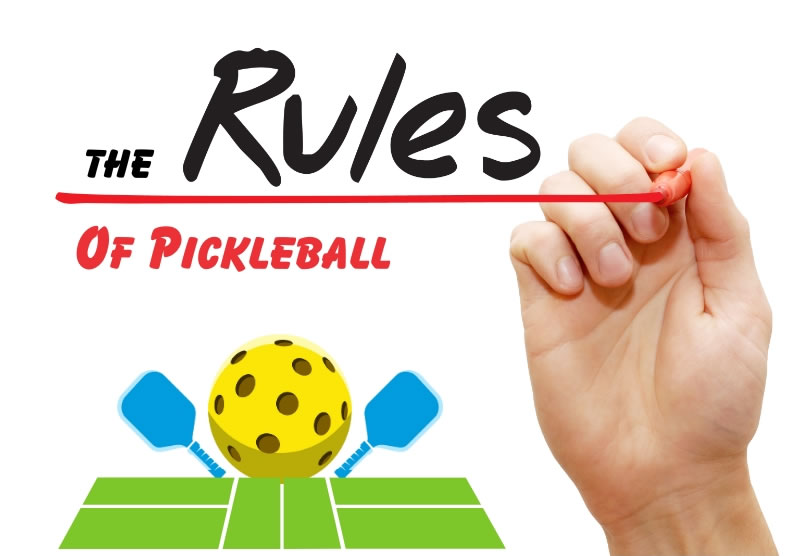
Pickleball General Game Rules
- A pickleball game must be played on a court with dimensions of 20 feet by 44 feet and with a net in the middle of the court.
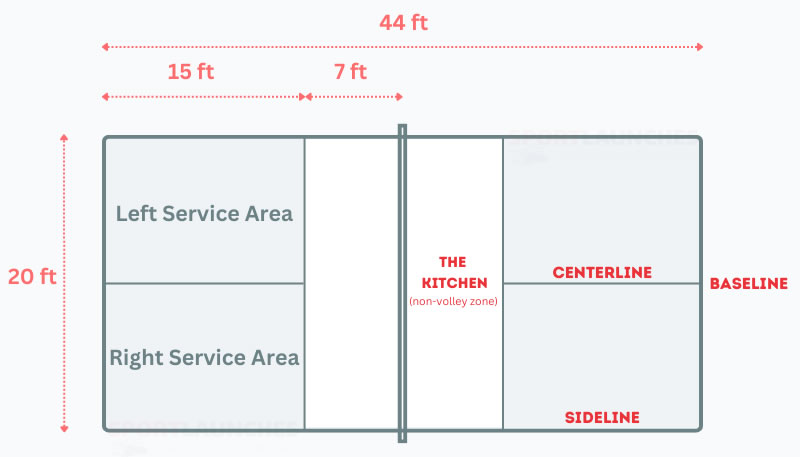
- A pickleball game can be played with two players, also known as singles pickleball, or with four persons, also known as doubles pickleball.
- All players must agree on a method for determining who serves first. Players can only use fair methods like a coin toss.
Player Position Rules
Player Positions Singles Pickleball
- The server and receiver positions are determined by the game score and the starting positions of the players.
- When starting the game, the first server must serve from the side of the court according to the 0-0 score, which is the right or even side of the court.
- Each server serves until they lose the rally or commit a fault.
- If the server wins the rally, they must switch to the other side of the court. For example, if the player started on the right/even side, they must move to the left/odd side.
- If the score is even (0, 2, 4, 6, 8, 10), the server must serve from the right/even side of the court.
- If the score is odd (1, 3, 5, 7, 9, 11), the server must serve from the left/odd side of the court.
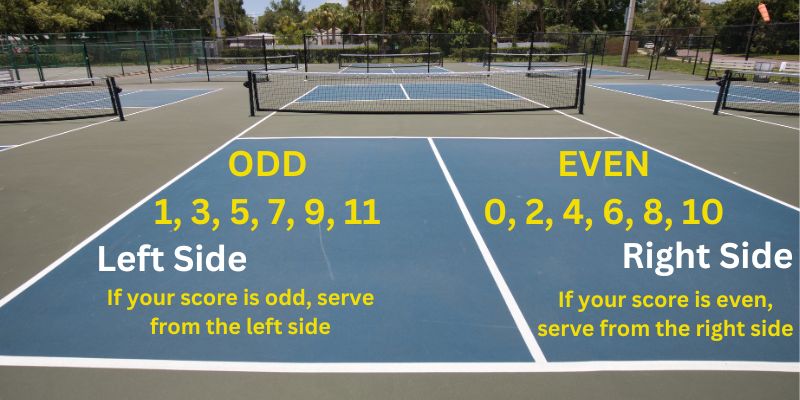
- When the server loses the rally or commits a fault, the ball goes to the other player on the other side of the court, resulting in a side out.
Player Positions Doubles Pickleball
- Both players of a team are allowed to serve until a side out. The only exception is the first serve of the game when only the first server serves.
- The starting serve of the first serve of a game is announced and considered as a second server, and the first server must shout 0-0-2.
- After each side out, the player on the right side of the court serves first.
- When the score of the team is even like 0,2,4,6,8,10, then the server is the one from the right/even area of the court. When the score is odd like 1,3,5,7,9,11, the server is the player from the left side of the court.
- When the first server of the team loses the rally or faults, then the second player of the team serves.
- If the serve is done by the incorrect player, then a fault is declared. If a point is scored meanwhile, then the score is not counted.
- The players are allowed to signal that they are not ready by raising the paddle above the head or by raising a hand above the head or turning with their back to the net.
Changing Court Ends in Pickleball
- In a 2-out-of-3 match with games played to 11 points, the third game will involve a switch of sides when the leading team reaches 6 points. The serving team will retain their serve.
- When playing a game to 15 points, the teams will switch sides once one team scores 8 points. The serving team will continue to serve.
- When playing a game to 21 points, the teams will switch sides once one team scores 11 points. The serving team will continue to serve.
Rules of Serving in Pickleball
- When serving, the server must shout out the score before hitting the ball to serve.
- When serving, the server must hit the ball to the diagonally opposite side of the opponent’s court.
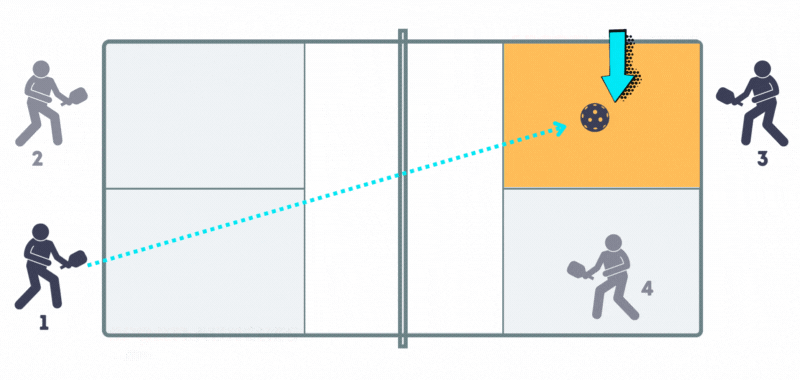
- When hitting the ball, the server must ensure that their arm follows an upward arc trajectory.
- When serving, the player can use only one hand.
- When serving, the server’s feet must not touch the court on or inside the baseline.

- When serving, the server cannot step beyond the imaginary extension of the sideline or centerline with either of their feet.

- When serving, the server must have one foot on the ground behind the baseline.
-
The 10-second rule. This pickleball rule says that once the server calls out the score, the server has only 10 seconds to serve the ball. If the server does not serve in 10 seconds, then it is declared a fault.
- The server is not allowed to manipulate or spin the ball before serving it.
- The server is allowed to use a volley serve or a drop serve.
- In official pickleball doubles games, if teammates want to change when serving, they should inform the referee. In non-official games, players should inform the other team about the change.
- According to the Pickleball Rulebook of the National Governing Body of American Pickleball, a proper volley serve includes the following elements:
- The player can use only one arm to serve.
- The paddle head must not pass the highest part of the wrist of the player.
- The player should raise the paddle for ball contact.
- The contact between the paddle and ball must not be made above waist level.
- According to the Pickleball Rulebook of the National Governing Body of American Pickleball, a proper drop serve includes the following elements:
- The player must release the ball in a natural way so that it bounces on the court surface.
- The player is not allowed to use force when dropping the ball on the court.
- The server has only one attempt to serve.
Rules for Returning of Serve in Pickleball
- The serve must be returned in accordance with the ‘two-bounce’ rule, which means allowing the ball to bounce before hitting it back.
- The serve must be returned by the correct player.
The kitchen Rules
- All volleys must happen outside of the kitchen or non-volley area.
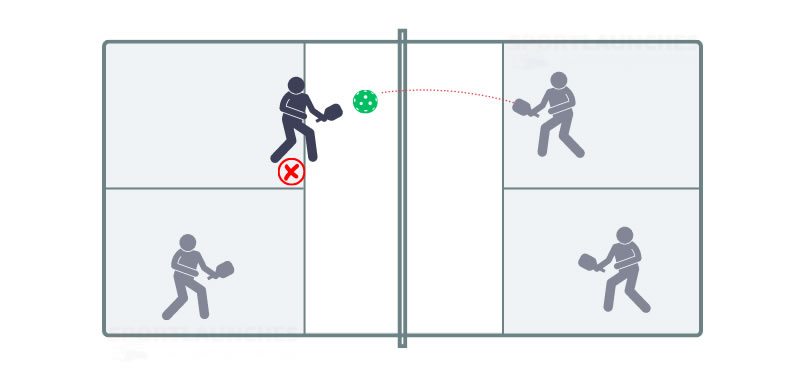
- If the player hitting the volley, or anything they touch, enters the non-volley zone while in the act of volleying, it will result in a fault.
- Players can enter the non-volley zone at any time, except when they are hitting a volley.
- Players can enter the kitchen or non-volley zone before or after hitting the ball.
- In doubles, it is not considered a fault or violation if one teammate stands in the kitchen area while the other teammate outside the kitchen area returns the ball.
- It’s allowed for a player to be inside the non-volley zone to return a ball that has bounced, and they won’t be penalized if they stay inside the non-volley zone after hitting the ball.
Line Call Rules
- If a ball served over the net lands within the correct service court or on a correct service court line without touching the non-volley zone, it is considered in play.
- Any ball that is hit during the game and lands within the boundaries of the court or touches any of the court lines is considered in play, with the exception of the serve.
- Any ball that comes into contact with the playing surface outside the court boundaries is considered out of play.
- Players are responsible for calling out all faults on their side.
- Players are allowed to call a ball out if they clearly state the distance between the line and the ball landing area.
- If a player did not see where the ball landed, they can ask the referee to make the call. If the referee is unable to make the call, the ball is considered in play.
- Spectators are not allowed to make calls and they cannot be involved in any decision-making.
- In doubles pickleball, if one player calls the ball out and the other calls it in, the ball is considered in play.
- Out line calls must be signaled loudly with either voice or hand signals. The call should be made by the player after the ball has bounced.
- If the player makes the call before the ball bounces, it is considered simple player communication.
Referee Rules
- All official matches must have a referee present to oversee the game.
- The referee has the authority to call for a replay of the score or the serve itself if necessary.
- The referee can make a call before the return of the serve to ensure fair play.
- The referee must promptly call any faults that occur during the game.
- In non-officiated matches where there is no referee, the players are not permitted to request a replay.
Pickleball Rules about Faults and Dead Balls
Service foot faults
- If the server steps outside the imaginary boundary of the sideline with either foot, it is considered a fault.
- If the server does not keep both feet on the correct side of the imaginary centerline extension, it is considered a fault.
- If the server touches the court, including the baseline, with any part of his or her feet while serving, it is considered a fault.
Service Faults
- Serving from the wrong area of the court is a fault.
- Hitting the serve with the incorrect player is a fault.
- Serving a ball that touches an object before bouncing on the ground is a fault.
- Serving a ball that touches a player before being served is a fault.
- Serving a ball that lands on one of the non-volley/kitchen lines is a fault.
- Serving a ball that lands in the non-volley/kitchen area is a fault.
- Serving a ball that lands outside the pickleball court is a fault.
- If the ball is not served within 10 seconds after announcing the score, it is considered a fault.
Receiver Faults
- Returning the serve with the wrong player is a fault.
- Failing to respect the two-bounce rule by touching the served ball before it bounces once is a fault.
General Fault Rules
- Two-bounce rule: If the ball is hit by a player and it doesn’t bounce before they hit it again, or if their opponent doesn’t hit the ball before it bounces twice, then it’s a fault.
- Net rule: If a player hits the ball into the net or hits it over the net and it doesn’t land on the other side of the court, then it’s a fault.
- Between the net and net post: If a player hits the ball between the net and the net post, it’s a fault.
- Second bounce rule: If a player doesn’t hit the ball before it bounces for the second time, then it’s a fault.
- If a player touches the net, net posts, or the opponent’s court while the ball is in play, it is considered a fault.
- If a player’s clothing, equipment, or paddle touches the net, net posts, or opponent’s court during play, it is also considered a fault.
- When a player stops a live ball before it becomes dead (e.g., catching or halting the ball in mid-air before it hits the playing surface), it is considered a fault on the player.
- When a player hits the ball before it has completely crossed over to the opponent’s side of the net, it is called a violation or fault.
- Not following any other pickleball rules or violating them in any way will result in a fault.
Dead Ball Rules
- Any action that stops the game will result in a dead ball.
- If a fault is committed and called out by the referee or player, the ball is considered dead.
- If the ball touches an object after bouncing on the opponent’s side of the court, it will be considered a dead ball.
- A hinder results in a dead ball. If a player is distracted during the game, they or the referee may call a hinder. If the hinder is declared invalid, the player or team will be considered to have committed a fault.
Scoring rules of pickleball
- Only the serving team can score points.
- A point can be scored when the opponent’s team commits a fault or fails to return the ball.
- Each point is worth the same value of 1 point.
- The first team that scores 11 points and leads by at least 2 points wins the game.
Pickleball Court Rules
- The standard pickleball court must have the following measurements: 20 feet wide and 44 feet long. These court dimensions apply to both singles and doubles games.

- All lines on the court must be 2 inches wide, of the same color, and in contrast to the playing surface.
- The court should be divided into service courts, with the right/even and left/odd sides distinguished, as well as non-volley or kitchen areas.
- There are three other types of playing surfaces with different dimensions that can be used:
Purpose Width feet (m) Length feet (m) New Construction 34 (10.36 m) 64 (19.5 m) Tournament Play 34 (10.36 m) 64 (19.5 m) Wheelchair Play 44 (13.41 m) 74 (22.56 m) Stadium Court 50 (15.24 m) 80 (24.38 m)
Lines and Areas
- The baseline lines must be perpendicular to the net on each side of the pickleball court.
- The sideline lines must be perpendicular to the net on each side of the pickleball court.
- The non-volley area, also known as the kitchen, must be 7 feet deep from the net to the back on each side of the court.
- The right side of the court is considered the even side, while the left side of the court is considered the odd side.
Net Specifications
- The net of the pickleball court can be made from a variety of mesh fabric materials.
- The net should not allow any ball to pass through it.
- The distance between the two posts of the net should be 22 feet.
- The net height should be at least 36 inches.
Pickleball Equipment Rules
Apparel
- Players must dress appropriately and with good taste.
- Players cannot wear clothes that are the same color as the pickleball ball.
- If a player is not dressed in appropriate attire or in the color of the ball, then the player can be requested to change clothes.
- All graphics and pictures on clothing must be in good taste and not offensive.
- Shoes must have sturdy soles that do not leave marks on the court surface.
Paddle Specifications
- The paddle must be made from materials accepted by USA Pickleball, such as graphite, carbon fiber, fiberglass, or wood.
- The surface of the paddle must be flat and smooth.
- Players can alter the paddle by adding tapes or rubber for better grip.
- The paddle can have handwritten marks as long as they don’t affect the landing surface of the ball.
Ball Specifications
- Outdoor pickleball games require a ball with small holes.
- Indoor pickleball games require a ball with large holes.
- The ball should have a minimum of 26 holes and a maximum of 40 circular holes.
- In tournaments, the ball must be chosen by the Tournament Director.
- The ball must be made of durable molded materials and have a smooth surface.
- The ball should have a solid color.
Other Pickleball Rules
- Double hits rule: Balls can be hit twice, but only by the same player. If the ball is hit during a rally by another player, it is considered a fault.
- Switching hand rule: A player can switch the paddle from one hand to the other during the game. Two-handed shots: A player can hit the ball by holding the paddle with both hands.
- Missed shot rule: If a player misses the ball while trying to hit it, the ball stays in play until it bounces twice or until someone commits a fault.
- Broken Ball: If the ball is broken or scratched, the rally continues until somebody commits a fault.
- Player injured: If one of the players suffers an injury, the rally continues until somebody commits a fault.
- Distractions: Players should not distract each other when trying to hit the ball.
Bibliography:
– Official USA Pickleball Rulebook / usapickleball.org
